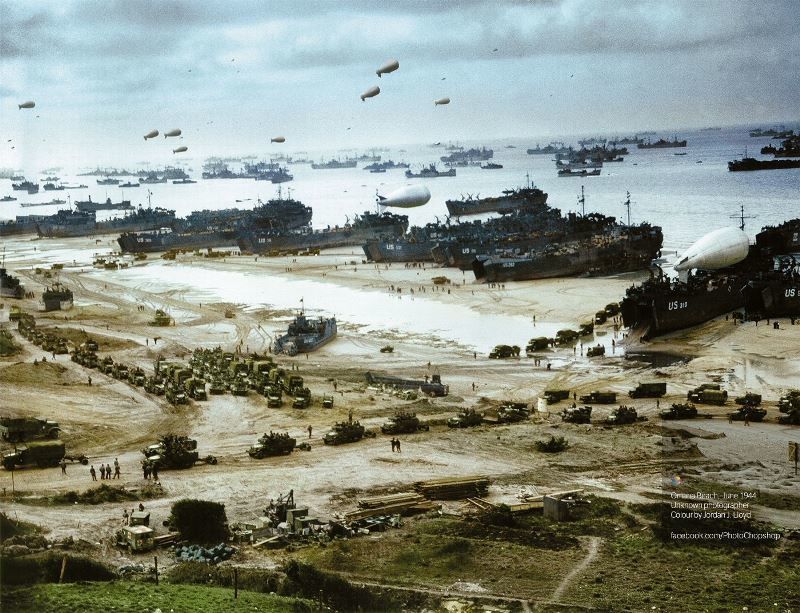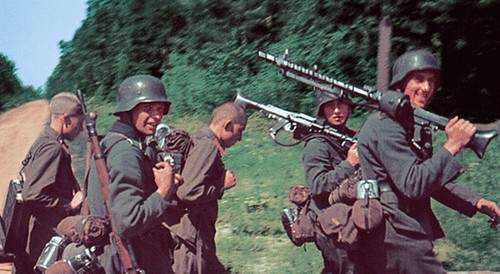Gambar Berwarna & Eksklusif Selepas 70 Tahun D-Day Penaklukan Normandy
Pertempuran Normandie berlaku pada tahun 1944 antara Jerman Nazi di Eropah Barat dan tentera Pihak Berikat yang menyerang sebagai sebahagian daripada konflik yang lebih besar untuk Perang Dunia Kedua. Operasi Overlord merupakan nama kod untuk serangan Pihak Berikat terhadap barat laut Eropah, yang bermula pada 6 Jun, 1944, dan tamat pada 19 Ogos, 1944, semasa Tentera Berikat merentasi Sungai Seine. Hingga ke enam puluh tahun selepas itu, Pertempuran Normandie ini masih kekal sebagai penyerangan amfibia yang terbesar dalam sejarah, melibatkan hampir 3 juta tentera melintasi Selat Inggeris dari England ke Normandie. Operasi Neptune merupakan nama kod bagi serangan fasa permulaan untuk Operasi Overlord; matlamatnya, untuk menambah foothold (tapak) pada benua itu, bermula pada 6 Jun 1944 (sering dikenali sebagai D-Day) dan tamat pada 30 Jun 1944.
Pembentukan Tentera Berikat yang utama adalah dari Amerika Syarikat, United Kingdom dan Kanada. Tentera Perancis Bebas dan tentera Poland juga menyertai pertempuran ini selepas fasa permulaan serangan itu, dan juga ada kontinjen dari Belgium, Czechoslovakia, Greece, Belanda, dan Norway.


Gambar-gambar penaklukan D-day Normandy ketika Perang Dunia Kedua. Daripada persiapan tentera British dan Amerika untuk operasi tersebut di England sehinggalah tawanan Jerman berarak di jalanan selepas pembebasan Perancis, imej-imej ini adalah hanya sebahagian daripada gambar berwarna yang diambil ketika perang itu. Set kepunyaan German Galerie Bilderwelt, iaitu koleksi eksklusif Hulton Archive untuk Getty Image.

Some of the first American soldiers to attack the German defenses in Higgins Boats (LCVPs) approach Omaha Beach near Normandy, France on June 6, 1944. Plastic covers protect the soldier's weapons against from the water. (Photo by Robert F. Sargent, U.S. Coast Guard/Galerie Bilderwelt/Getty Images) #

Allied ships, boats and barrage balloons off Omaha Beach after the successful D-Day invasion, near Colleville-sur-Mer, Normandy, France on June 9, 1944. (Photo by Galerie Bilderwelt/Getty Images) #

British Navy Landing Crafts (LCA-1377) carry United States Army Rangers to a ship near Weymouth in Southern England on June 1, 1944. British soldiers can be seen in the conning station. For safety measures, U.S. Rangers remained consigned on board English ships for five days prior to the invasion of Normandy, France. (Photo by Galerie Bilderwelt/Getty Images) #

A U.S. Landing Craft Infantry (LCI) filled with invasion troops approaches the French coast from the sea in June of 1944. The GIs wear life vests in preparation for the landing. (Photo by Galerie Bilderwelt/Getty Images) #

Planes from the 344th Bomb Group, which led the IX Bomber Command formations on D-Day on June 6, 2014. Operations started in March 1944 with attacks on targets in German-occupied France, Belgium, and the Netherlands. After the beginning of the Normandy invasion, the Group was active at Cotentin Peninsula, Caen, Saint-Lo and the Falaise Gap. (Photo by Galerie Bilderwelt/Getty Images) #

Private Clyde Peacock, 1st Military Police (MP) Platoon of the 1st Infantry Division of the United States Army in June 1944 in Dorset, United Kingdom. The 1st Division was one of the two divisions that stormed Omaha Beach on D-Day suffering high casualties. (Photo by Galerie Bilderwelt/Getty Images) #

Troops from the 3rd Canadian Infantry Division landing at Juno Beach on the outskirts of Bernieres-sur-Mer on D-Day, June 6, 1944. 14,000 Canadian soldiers were put ashore and 340 lost their lives in the battles for the beachhead. (Photo by Galerie Bilderwelt/Getty Images) #

An Allied plane crash burns during the fighting in Normandy, France in June of 1944. (Photo by Galerie Bilderwelt/Getty Images) #

German Prisoners of War are kept behind barbed wire on Omaha Beach on June 10, 1944. Landing Ship, Tanks can be seen on the beach and barrage balloons in the air for protection. (Photo by Galerie Bilderwelt/Getty Images) #

From left, Chief of the Imperial General Staff Field Marshal Sir Alan Brooke, British Prime Minister Winston Churchill and commander of the 21st Army Group, Field Marshal Bernard Montgomery in Normandy on June 12, 1944, six days after the D-Day landings during Operation Overlord Normandy in World War II. (Photo by Galerie Bilderwelt/Getty Images) #

Trucks of the 1st Infantry Division of the United States Army are loaded into a Landing Ship Tank (LST) in Dorset, United Kingdom, on June 5th, 1944. The LST forms part of Group 30 of the LST Flotilla. The 1st Division was one of the two divisions that stormed Omaha Beach in Normandy, France on D-Day suffering high casualties. It secured Formigny and Caumont in the beachhead. D-Day is still one of the world's most gut-wrenching and consequential battles, as the Allied landing in Normandy led to the liberation of France which marked the turning point in the Western theater of World War II. (AFP PHOTO/Getty Images) #

Two American soldiers watch U. S. Army jeeps driving through the ruins in Saint-Lo in August of 1944. The town was almost totally destroyed by 2,000 Allied bombers when they attacked German troops stationed there during Operation Overlord Normandy in June. (Photo by Galerie Bilderwelt/Getty Images) #

Jeeps and other U. S. Army vehicles drive through the ruins of Saint-Lo in August of 1944. The town was almost totally destroyed by 2,000 Allied bombers when they attacked German troops stationed there during Operation Overlord Normandy in June. (Photo by Galerie Bilderwelt/Getty Images)

German Prisoners of War are kept behind barbed wire in Normandy, France in June of 1944. More than 200,000 German soldiers were captured during the Battle of Normandy. (Photo by Galerie Bilderwelt/Getty Images) #

A farmer and his son in front of their damaged house during the Allied invasion of France in July of 1944. Bombing of German positions caused damage throughout the area. (Photo by Galerie Bilderwelt/Getty Images) #

Signal Corps photographer Sergeant Fred Bornet films a town in Normandy, France in June of 1944. Fred 'Freddy' Bornet was born in Scheveningen, Holland. Fluent in French, English and German, he migrated to the United States in 1939 as a 24 year old primarily to escape Hitler. He then became a member of the 163rd Signal Corps Company. (Photo by Galerie Bilderwelt/Getty Images) #

American troops with German prisoners of war on board a Landing Craft Transport (LCT) in June of 1944. The prisoners will be taken to a Liberty Ship in the English Channel during the Allied invasion of Normandy. (Photo by Galerie Bilderwelt/Getty Images) #

United States Rangers from E Company, 5th Ranger Battalion, on board a landing craft assault vessel (LCA) in Weymouth harbor, Dorset, on June 4, 1944. The ship is bound for the D-Day landing on Omaha Beach in Normandy. Clockwise, from far left: First Sergeant Sandy Martin, who was killed during the landing, Technician Fifth Grade Joseph Markovich, Corporal John Loshiavo and Private First Class Frank E. Lockwood. They are holding a 60mm mortar, a Bazooka, a Garand rifle and a pack of Lucky Strike cigarettes. (Photo by Galerie Bilderwelt/Getty Images) #

The 1st Infantry Division of the United States Army (The 'Big Red One') in Dorset, United Kingdom on June 5, 1944 before departing for Omaha Beach. (Photo by Galerie Bilderwelt/Getty Images) #

U.S. Army Medics treating two GIs at a first aid post in southern England in 1944. The soldiers are among the troops due to embark for the invasion of Normandy. (Photo by Galerie Bilderwelt/Getty Images) #

A truck from the 1st Infantry Division of the United States Army is loaded into the Landing Ship Tank in Dorset, United Kingdom in June of 1944. The LST forms part of Group 30 of the LST Flotilla. The 1st Division was one of the two divisions that stormed Omaha Beach in Normandy, France on D-Day suffering high casualties. (Photo by Galerie Bilderwelt/Getty Images) #
Dapatkan lebih banyak info terkini di Channel Rasmi Cari Dot My
|




























